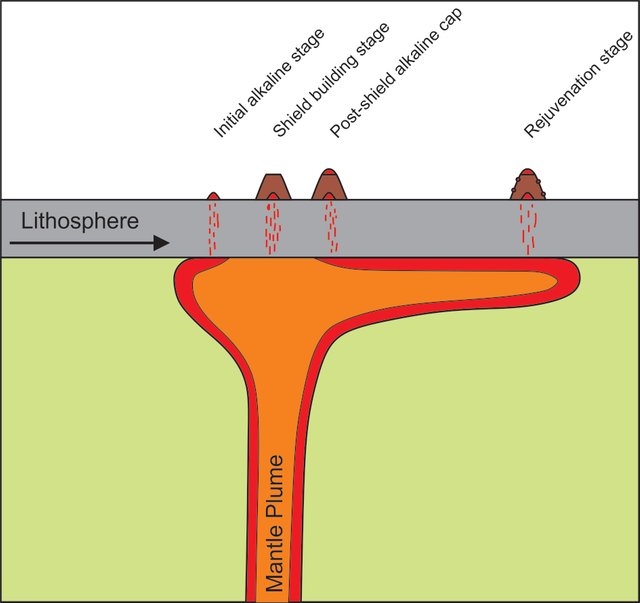Hawaiian volcanoes - Part 4: The Rejuvenation Stage
In my last post I talked about the growth stages of a Hawaiian volcano while it moves across the hotspot.
The model in which the Pacific plate wanders across this stationary hotpot would imply that as soon as the island has left the hot spot, its volcanism will stop.
Some Hawaiian volcanoes coma back to life after they have left the hot spot. This stage in the life cycle of a Hawaiian volcano is termed the Rejuvenation stage.
The volume of this rejuvenated volcanism is extremely small, compared to the main shield-building phase (less than 1%). The time difference between the end of the alkaline cap and the new rejuvenated magmatism lies between 0.5 and 2.6 million years. That means, during the rejuvenation stage the volcanoes are between 200 and 400 km away from the hotspot.
The erupting lavas are highly alkalic and erupt through vents, usually forming a small cinder cone or a scatter cone. If the magma solidifies directly within a fault or vent it is called a dike.

Diagram showing the evolution of a Hawaiian volcano including the Rejuvenation stage.
Drawn by author
The cause for this rejuvenated volcanism is not completely understood and scientists are still debating. Currently three models have been proposed:
Model 1: Melting of the oceanic lithosphere [1].
Heat from the plume gets transported laterally along with the direction of the Pacific plate. This heat will accumulate downstream until it reached amounts where the oceanic lithosphere starts to melt, creating the rejuvenated magmatism.
Currently, researchers believe this scenario to unlikely be responsible for the production of rejuvenated stage magmatism [2]. Comparison of elemental concentrations and isotopic values have shown no similarity between sampled rejuvenated lavas and the Pacific lithosphere. The composition of the lithosphere has been determined using mantle xenoliths from Hawaiian volcanoes.
Model 2: Decompressional melting of the plume as a result of lateral spreading beneath the lithosphere [3].
It has been modelled where the plume would be flowing after it hits the lithosphere. Anywhere this material flows upward, decompression melting will happen. This is the same process that melting in the main plume column is happening. After melt got extracted, the remaining material sinks back a little bit and melting will stop. During the transport away from the plume center, the material starts to spread laterally against the base of the lithosphere. This spread means thinning of the material against the lithosphere on top. While the material thins the bottom of it will therefore move closer to the lithosphere, upwards. This upward movement means a decrease in pressure which then leads to rejuvenated melting.
Model 3: Flexural uplift related to loading the lithosphere above the plume column [4].
During the main growth phase of the volcanoes, large amounts of weight are added to the lithosphere. This added weight presses down on the underlying mantle. The underlying mantle gets squeezed away and to compensate for this, the area around the subsidence will be uplifted. This upward movement could result in loss of pressure and induce melting.
Concluding Remarks
Eruptions of Hawaiian volcanoes show evidence for two phases of volcanism. A first phase in which massive shield volcanoes are formed above a mantle plume and a second, rejuvenated stage, which erupts tiny amounts of lava hundreds of kilometers away from the plume center. The exact origin of this rejuvenated magmatism is still under debate and we can look forward to great scientific works in the future.
Next time I will examine what happens to a Hawaiian volcano after magmatism has completely ceased, the last parts in the Life cycle of a Hawaiian volcano.
Previous posts
Hawaiian volcanoes - Part 1: Introduction
Hawaiian volcanoes - Part 2: The Hawaiian Hotspot
Hawaiian volcanoes - Part 3: A growing volcano
Sources
[1] Gurriet, P. (1987). A thermal model for the origin of post-erosional alkalic lava, Hawaii. Earth and Planetary Science Letters 82, 153-158
[2] Garcia, M., Swinnard, L., Weis, D., Greene, A.R., Tagami, T., Sano, H., Gandy, C.E. (2010). Petrology, Geochemistry and Geochronology of the Kaua’I Lavas over 4.5 Myr: Implications for the Origin of Rejuvenated Volcanism and the Evolution of the Hawaiian Plume. Journal of Petrology 51, 1507-1540.
[3] Ribe, N. M. & Christensen, U. R. (1999). The dynamical origin of Hawaiian volcanism. Earth and Planetary Science Letters 171, 517-531.
[4] Bianco, T. A., Ito, G., Becker, J. M. & Garcia, M. O. (2005). Secondary Hawaiian volcanism formed by flexural arch decompression. Geochemistry, Geophysics, Geosystems 6, 1-24.
Additional links
http://manoa.hawaii.edu/coe/kulia/publications/nsf/Hawaiian_evolution_rejuvenation_Kahua_Ao_HANDOUTS.pdf
http://volcano.oregonstate.edu/post-erosional-rejuvenation
https://volcanoes.usgs.gov/observatories/hvo/hawaiian_volcanoes.html
You received a 80.0% upvote since you are a member of Geopolis.
To read more about us and what we do, click here.
https://steemit.com/geopolis/@geopolis/geopolis-the-community-for-global-sciences-update-4
Congratulations @sooflauschig! You have completed some achievement on Steemit and have been rewarded with new badge(s) :
Click on any badge to view your own Board of Honor on SteemitBoard.
For more information about SteemitBoard, click here
If you no longer want to receive notifications, reply to this comment with the word
STOPYou just planted 0.27 tree(s)!
Thanks to @sooflauschig
We have planted already 3802.92 trees
out of 1,000,000
Let's save and restore Abongphen Highland Forest
in Cameroonian village Kedjom-Keku!
Plant trees with @treeplanter and get paid for it!
My Steem Power = 20782.24
Thanks a lot!
@martin.mikes coordinator of @kedjom-keku